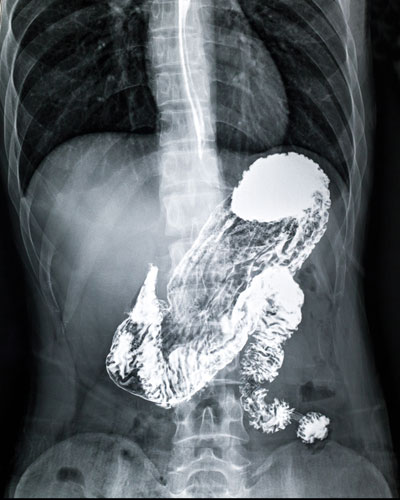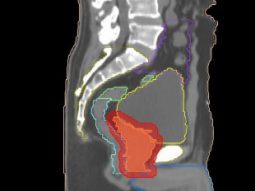WHAT IS A BARIUM STUDY?
Barium study is an x-ray examination of the oesophagus, stomach, small and large intestine whereby the gastrointestinal tract must be coated or filled with a contrast material called barium, an element that appears bright white on radiographs or – x-ray films. Additionally, some gas is introduced to further improve the images; this procedure has the modified name of “air-contrast” or “double-contrast study.”
For the upper gastrointestinal study it is called barium meal or barium meal with follow through if it is required to visualize the small intestines. For the lower gastrointestinal study, it is called barium enema.

WHAT ARE THE COMMON USES OF THIS PROCEDURE?
For barium meal: to observe digestive function or to detect abnormalities such as ulcers, tumours or inflammation of the oesophagus, stomach and duodenum.
For barium enema: to observe the large bowels to look for ulcers, benign tumours (polyps, for example), cancer, or signs of certain other intestinal illnesses.
WHAT ARE THE BENEFITS AND RISKS?
BENEFITS
This is an extremely safe, non invasive procedure with rare complications.
You may return to normal activity following the examination.
The imaging process is fast and well-tolerated.
Radiology examination can often provide enough information to avoid more invasive procedures such as colonoscopy.
RISKS
Some patients may be allergic to the flavouring added to some brands of barium. If you have experienced allergic reactions after eating chocolate, certain berries or citrus fruit, be sure to tell your doctor or the diagnostic radiographer before the procedure.
There is a slight chance that some barium could be retained, leading to a blockage of the digestive system. Therefore, patients who have an obstruction in the gastrointestinal tract should not undergo this examination.
The radiation dose from this procedure is about the same as the average person receives from background radiation in eight to sixteen months.
HOW SHOULD I PREPARE FOR THE EXAMINATION?
For barium meal, a fasting period of 8 hours is required before the examination. This will include not having food or drinks.
For barium enema, you will be given medications and specific instructions by your requesting doctor to clear your bowels before the examination.
Before performing barium study, women should always inform their doctor or the diagnostic radiographer if they are pregnant or if there is any possibility that they are pregnant.
HOW IS THE PROCEDURE PERFORMED?
Barium meal
You will be asked to step on the pedestal of the x-ray machine.
Then you will be asked to drink a cup of liquid barium, which resembles a white-coloured milkshake, with a chalky taste.
The radiologist and/or the diagnostic radiographer will note the passage of barium into your oesophagus and stomach on the fluoroscopic monitor.
The table will then be moved to a horizontal position and you will then be lying down as the radiologist and/or the diagnostic radiographer obtains pictures of your oesophagus, stomach and duodenum.
You will be asked to hold your breath to prevent blurring of the still images. Also, periodically you will be asked to move into different positions while standing and to roll into different positions while lying on the examining table.
The examination is usually completed within 20 minutes.
If a follow through is required you will be asked to wait from about 30 minutes to a few hours to follow the passage of barium through your intestines. X-rays of your abdomen will be periodically taken.
Barium enema
You will be positioned on your side on the x-ray table.
A rectal tube is then introduced into the rectum.
The radiologist or the diagnostic radiographer will introduce a mixture of barium and water into your colon through the tube.
Air may also be injected through the tube to help the barium thoroughly coat the lining of the colon.
You may be repositioned frequently to enable the radiologist and/or the diagnostic radiographer to capture views of the colon from several angles. When images are taken, you will be asked to hold your breath to ensure clear pictures of your colon are recorded.
Once the x-ray images are completed, most of the barium is drawn back into a bag, and the patient is directed to the washroom to expel the remaining barium and gas.
The examination usually takes about 30 to 60 minutes.

WHAT HAPPENS AFTER THE PROCEDURE?
You can resume a regular diet and take orally administered medications unless told otherwise by your doctor.
You are encouraged to drink additional water for 24 hours after the examination to avoid constipation.
The barium may colour stools gray or white for 48 to 72 hours after the procedure.
WHEN CAN I EXPECT RESULTS?
Your examination will be reviewed by a radiologist. Your requesting doctor will be informed immediately of any suspicious findings. You will receive a formal written report on the same day or within two days depending on your clinical and diagnostic requirements.
How do I schedule the exam?

 Vi
Vi 












